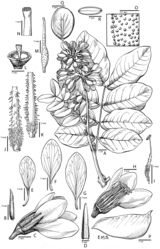Stuhlmannia
| Notice: | This page is derived from the original publication listed below, whose author(s) should always be credited. Further contributors may edit and improve the content of this page and, consequently, need to be credited as well (see page history). Any assessment of factual correctness requires a careful review of the original article as well as of subsequent contributions.
If you are uncertain whether your planned contribution is correct or not, we suggest that you use the associated discussion page instead of editing the page directly. This page should be cited as follows (rationale):
Citation formats to copy and paste
BibTeX: @article{Gagnon2016PhytoKeys, RIS/ Endnote: TY - JOUR Wikipedia/ Citizendium: <ref name="Gagnon2016PhytoKeys">{{Citation See also the citation download page at the journal. |
Ordo: Fabales
Familia: Leguminosae
Name
Stuhlmannia Taub., Engler, Pflanzenw. Ost.-Afr. C: 201. 1895 – Wikispecies link – Pensoft Profile
Type
Stuhlmannia moavi Taub.
Description
Unarmed trees, to 25 m tall; bark brown, fissured and fibrous; young shoots eglandular or with small red glands. Stipules not seen. Leaves alternate, pinnate or bipinnate and then ending in a pair of pinnae, (1.5–) 5–11 (– 20 cm) long, pinnae in (1–) 2–10 pairs per leaf, with reddish glands; leaflets in 3–12 pairs per pinna, opposite to sub-opposite, elliptic, 7–75 (– 120) × 3–30 (– 60) mm, obtuse at the base and apex, glabrous, eglandular or with red glands on the lower surface. Inflorescence a 2–11 cm long, terminal or axillary raceme; pedicels 3–13 mm long. Flowers bisexual, sub-actinomorphic; calyx comprising a hypanthium and 5 sepals, these 5–6.5 mm long, valvate in bud, caducous; petals 5, free, yellow, the median petal with red markings, obovate, 9–12 × 3–6 mm, apex rounded, median petal slightly smaller than the others; stamens 10, free, 5.5–8 mm long, filaments pubescent; ovary stipitate, with red sessile glands, glabrous to pubescent. Fruit a flattened, oblong, woody, elliptic pod with an acuminate apex, 4.5–6 × 1.5–2 cm, dehiscing along both sutures, valves twisting, glabrous to thinly puberulous. Seeds flattened, sub-circular to ovate, c. 10–13 × 8–9 mm, brown.
Geographic distribution
A monospecific genus in E Africa (Kenya and Tanzania) and N Madagascar.
Habitat
Seasonally dry tropical forest, woodland on limestone and in riverine forest.
Etymology
Named by Taubert for the German naturalist Franz Ludwig Stuhlmann (1863–1928).
References
Brenan (1967[1]: 45–47); Capuron (1967[2], under Caesalpinia insolita); Lewis (1996)[3]; Du Puy and Rabevohitra (2002[4]: 48, 50, under Caesalpinia insolita); Lemmens (2010)[5].
Taxon Treatment
- Gagnon, E; Bruneau, A; Hughes, C; de Queiroz, L; Lewis, G; 2016: A new generic system for the pantropical Caesalpinia group (Leguminosae) PhytoKeys, (71): 1-160. doi
Images
|
Other References
- ↑ Brenan J (1967) Leguminosae, part 2: subfamily Caesalpinioideae. In: Milne-Redhead E Polhill R (Eds) Flora of Tropical East Africa. Crown Agents for Oversea Goverments and Administration, London.
- ↑ Capuron R (1967) Deux Caesalpinia nouveaux pour Madagascar. Adansonia (série 2) 7(2): 199–205.
- ↑ Lewis G (1996) Notes on Stuhlmannia Taub. and the correct placement of Caesalpinia insolita (Harms) Brenan & J.B. Gillett (Leguminosae: Caesalpinioideae: Caesalpinieae). Kew Bulletin 51(2): 377–379. doi: 10.2307/4119334
- ↑ Du Puy D, Rabevohitra R (2002) Tribe Caesalpinieae. In: Du Puy D Labat J Rabevohitra R Villiers J Bosser J Moat J (Eds) The Leguminosae of Madagascar. Kew Royal Botanic Gardens, Richmond, 20–59.
- ↑ Lemmens R (2010) Stuhlmannia moavi Taub. In: Lemmens R Louppe D Oteng-Amoako A (Eds) PROTA (Plant Resources of Tropical Africa / Ressources végétales de l’Afrique tropicale). Wageningen, Netherlands. http://www.prota4u.org/protav8.asp?en=1&p=Stuhlmannia+moavi [accessed 15.05.2015]

